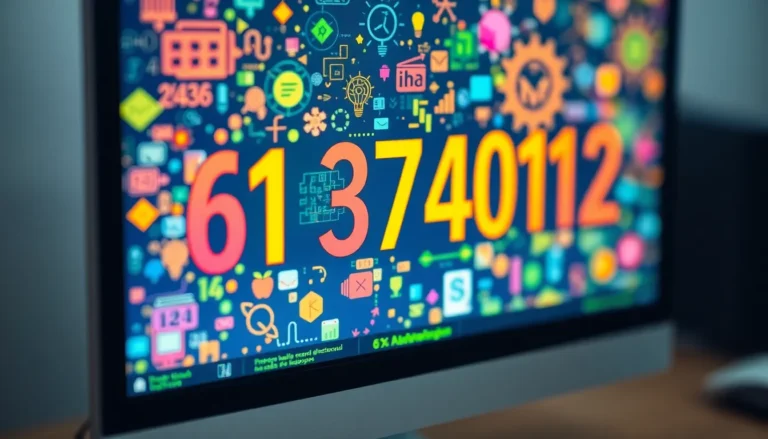In a world where chatbots churn out text faster than a caffeinated squirrel on a keyboard, figuring out if an article is penned by ChatGPT can feel like a game of literary hide-and-seek. With AI writing becoming more sophisticated, the lines between human and machine-generated content are blurrier than ever. But fear not! There are clever tricks to uncover the truth lurking behind the words.
Table of Contents
ToggleUnderstanding ChatGPT and Its Writing Style
Understanding ChatGPT provides insights into its unique writing style and characteristics. This knowledge aids in distinguishing AI-generated text from human-written content.
What is ChatGPT?
ChatGPT is an advanced AI model developed by OpenAI. It processes natural language to generate responses based on input. Relying on extensive datasets, it learns language patterns, grammar, and context. Utilization spans various applications, including customer support and content creation. Depending on user interactions, it refines its output to align with specific requests. This adaptability enhances its effectiveness, making it a valuable tool for many tasks.
Common Characteristics of ChatGPT Text
ChatGPT text exhibits several distinct characteristics. Responses typically display a neutral tone, lacking strong personal opinions or emotions. Phrasing often remains formal and structured, without informal language or slang. Clarity and coherence mark its sentences, ensuring easy readability. Repetition of themes and phrases occasionally occurs, reinforcing concepts without unique variations. Additionally, it avoids excessive detail, focusing on concise information delivery. Overall, these features contribute to recognizing AI-generated content effectively.
Methods to Identify ChatGPT-Written Text

Identifying whether text is generated by ChatGPT involves specific analytical methods. These techniques focus on language patterns and coherence traits unique to AI writing.
Analyzing Language Patterns
Observing word choice offers insights into AI text. ChatGPT often utilizes formal phrases and maintains a neutral tone. The repetition of specific phrases indicates a lack of creativity. Sentences typically exhibit uniform structures, contrasting with human diversity in expression. An over-reliance on common vocabulary can also signal AI involvement.
Checking for Coherence and Depth
Evaluating the overall coherence aids in detection. AI-generated content may lack depth in complex topics, presenting surface-level understanding. Inconsistencies in argumentation or illogical transitions often arise. A clear, logical flow is usually absent in this kind of writing, highlighting its mechanical nature. Engaging human writing tends to offer detailed explanations and nuanced perspectives, differentiating itself from AI output.
Tools and Resources for Detection
Various tools and resources can assist in detecting whether text originates from a human or AI like ChatGPT. Utilizing both software solutions and manual techniques enhances accuracy in identification.
Available Software Solutions
Several software programs help identify AI-generated text. Tools such as Turnitin and Copyscape evaluate writing styles and detect anomalies. Text Analyzer focuses on patterns and coherence to spot AI traits. For a more specialized approach, GPT-2 Output Detector analyzes text against AI models to distinguish between human and machine-generated content. These solutions leverage algorithms and databases to evaluate writing traits efficiently.
Manual Techniques for Identification
Examining text manually yields valuable insights into authorship. Inquiring about the depth of arguments often reveals gaps in AI writing. Assessing tone and style provides clues, especially if the text reads unusually formal or neutral. Spotting repetitive structures indicates machine-generated content. Reviewing the complexity of concepts can also highlight superficial understanding typical of AI. Observing these characteristics guides users in differentiating between human and AI authors effectively.
Ethical Considerations
Misidentifying the authorship of text raises significant ethical concerns. Consequences may include misleading attribution of ideas, which affects credibility and trust in content. Incorrect identification can also harm the reputation of writers inadvertently labeled as using AI. This misrepresentation creates a ripple effect that can undermine the integrity of both human and AI-generated content.
Awareness of implications drives the need for responsible use and interpretation of AI writing. Users must critically assess content before making claims about its origins. Understanding the role of algorithms in generating text encourages a balanced view of AI’s capabilities and limitations.
Transparency becomes crucial in the discourse surrounding AI-generated content. Clear labeling of AI-produced material fosters trust and accountability. It allows consumers to weigh the quality and reliability of the information. Open communication about the use of AI enhances the ongoing conversation about ethical standards and best practices. Emphasis on disclosure serves to create a more informed public, ensuring clarity in the rapidly evolving digital landscape.
Detecting whether content is written by ChatGPT or a human requires a keen eye and an understanding of specific traits. By recognizing the unique characteristics of AI-generated text and utilizing available tools, individuals can navigate the complexities of authorship with confidence.
The emphasis on responsible interpretation and transparency plays a vital role in maintaining credibility in the digital landscape. As AI continues to evolve, staying informed about its capabilities and limitations will empower readers to make more informed judgments about the content they encounter. This awareness fosters a more discerning approach to both human and AI contributions in writing.





